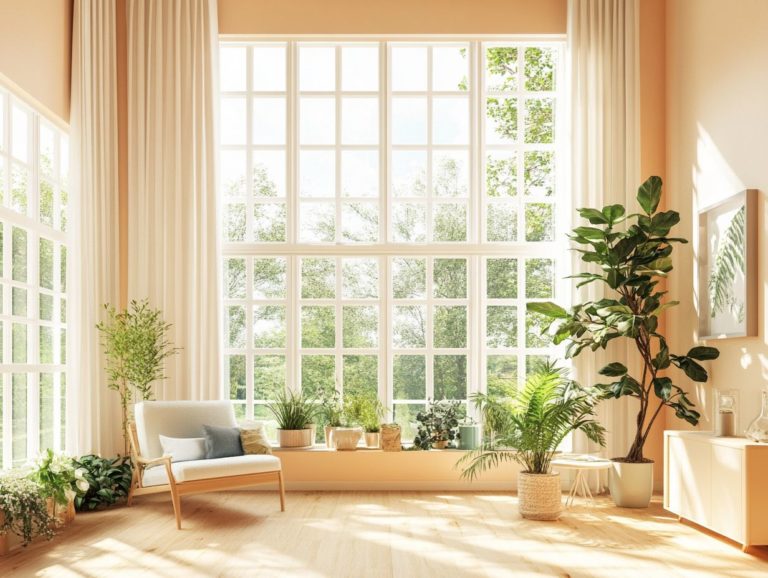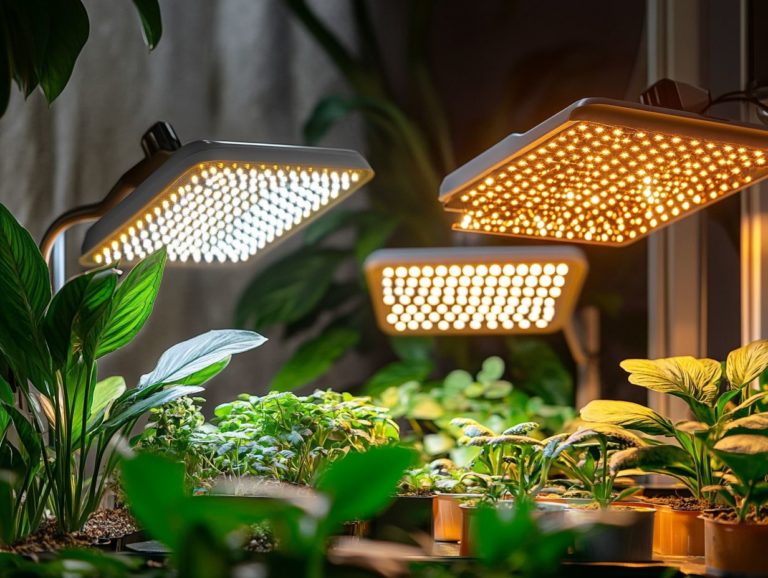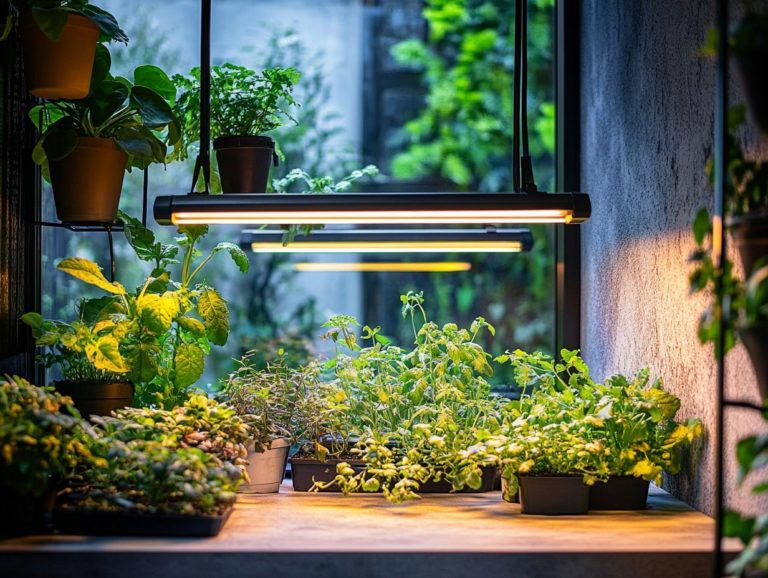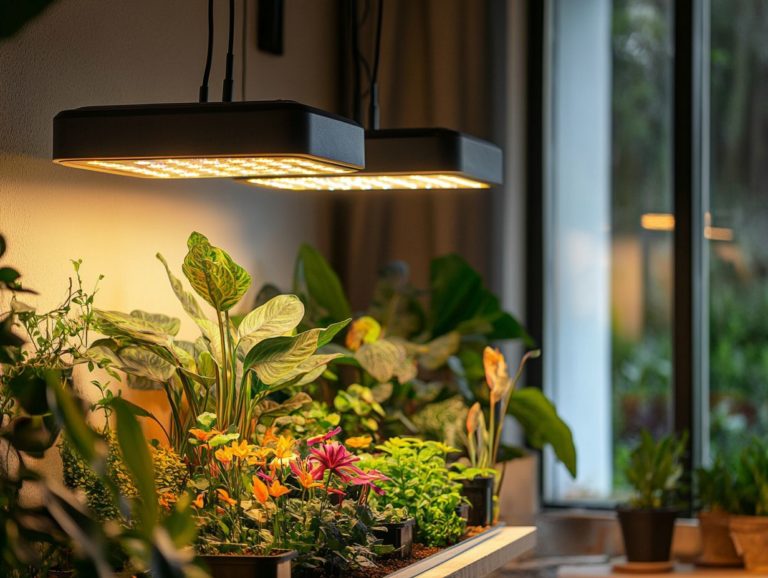Light Management for Indoor Orchids
Orchids are more than just stunning plants they’re a challenge and joy to grow! Their beauty hinges on one crucial factor: light, especially for optimal care.
Understanding the light requirements for these delicate plants is vital for thriving growth and vibrant blooms. This article explores the types of light that influence orchid development and offers practical tips for an effective lighting system.
You’ll encounter common light-related challenges. Discover best practices to maintain optimal light levels and ensure your orchids flourish.
Dive in to unveil the secrets of successful orchid care!
Contents
- Key Takeaways:
- Understanding Orchid Light Requirements
- Choosing the Right Light Source
- Setting Up a Lighting System for Orchids
- Common Light-Related Issues for Orchids
- Best Practices for Managing Light Levels
- Frequently Asked Questions
- What is light management for indoor orchids?
- Why is light management important for indoor orchids?
- What is the ideal light intensity for indoor orchids?
- How do you determine the right amount of light for your indoor orchids?
- What are the different types of light for indoor orchids?
- How do you create a good light management routine for your indoor orchids?
Key Takeaways:
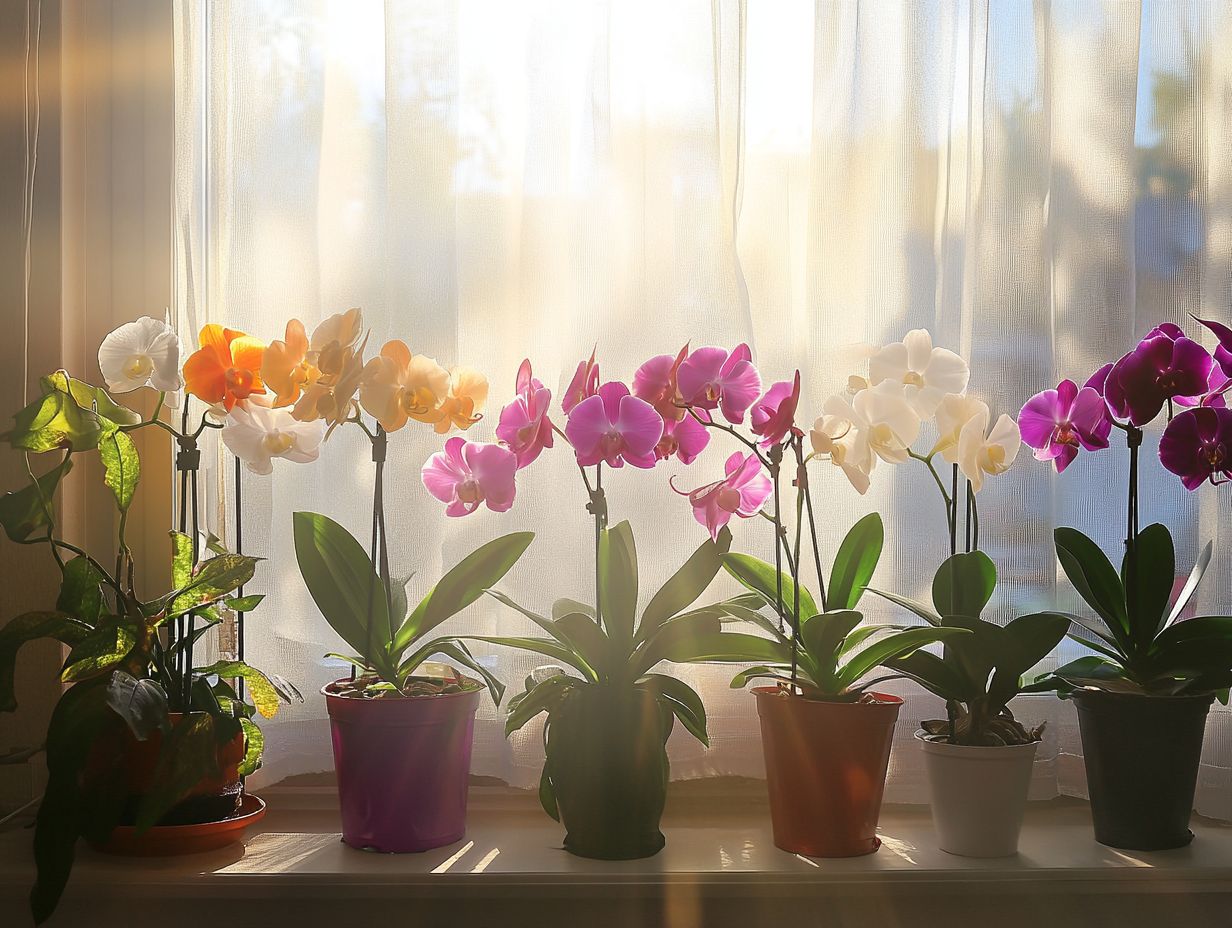
Understanding Orchid Light Requirements
Understanding the light requirements for your indoor orchids is essential for nurturing healthy plants. Orchids, part of the diverse Orchidaceae family, have varying light needs depending on their species.
For instance, popular varieties like Phalaenopsis and Dendrobium thrive in bright, indirect light. In contrast, Cattleya and Oncidium prefer a bit more direct sunlight.
Grasping these nuances can greatly influence your orchids’ growth and overall health. This knowledge is vital for any orchid enthusiast, especially those in tropical regions.
Types of Light and How They Affect Growth
Various types of light play a crucial role in the growth and health of your indoor orchids. Natural sunlight, fluorescent lighting, and LED grow lights are the primary sources.
Natural sunlight offers a full spectrum of light essential for photosynthesis (the process plants use to make food) and overall plant vibrancy. However, it can be too intense for certain varieties, risking burning if not filtered.
Fluorescent lighting is energy-efficient and cooler, ideal for growing orchids in tighter spaces. Ensure your plants receive the right light brightness.
LED grow lights are increasingly popular, as they deliver customizable spectrums that can be adjusted based on your orchid’s growth stage. Keep in mind that the initial investment might be high for some.
Understanding how each lighting type affects growth patterns and flowering cycles allows you to cultivate thriving orchids with vibrant foliage.
Choosing the Right Light Source
Selecting the ideal light source for your indoor orchids is crucial, significantly impacting their health and growth. Many orchid species thrive best under natural light, but artificial lighting can also be a viable alternative.
This creates optimal conditions for your orchids, particularly in less-than-ideal environments.
Natural vs Artificial Light Options
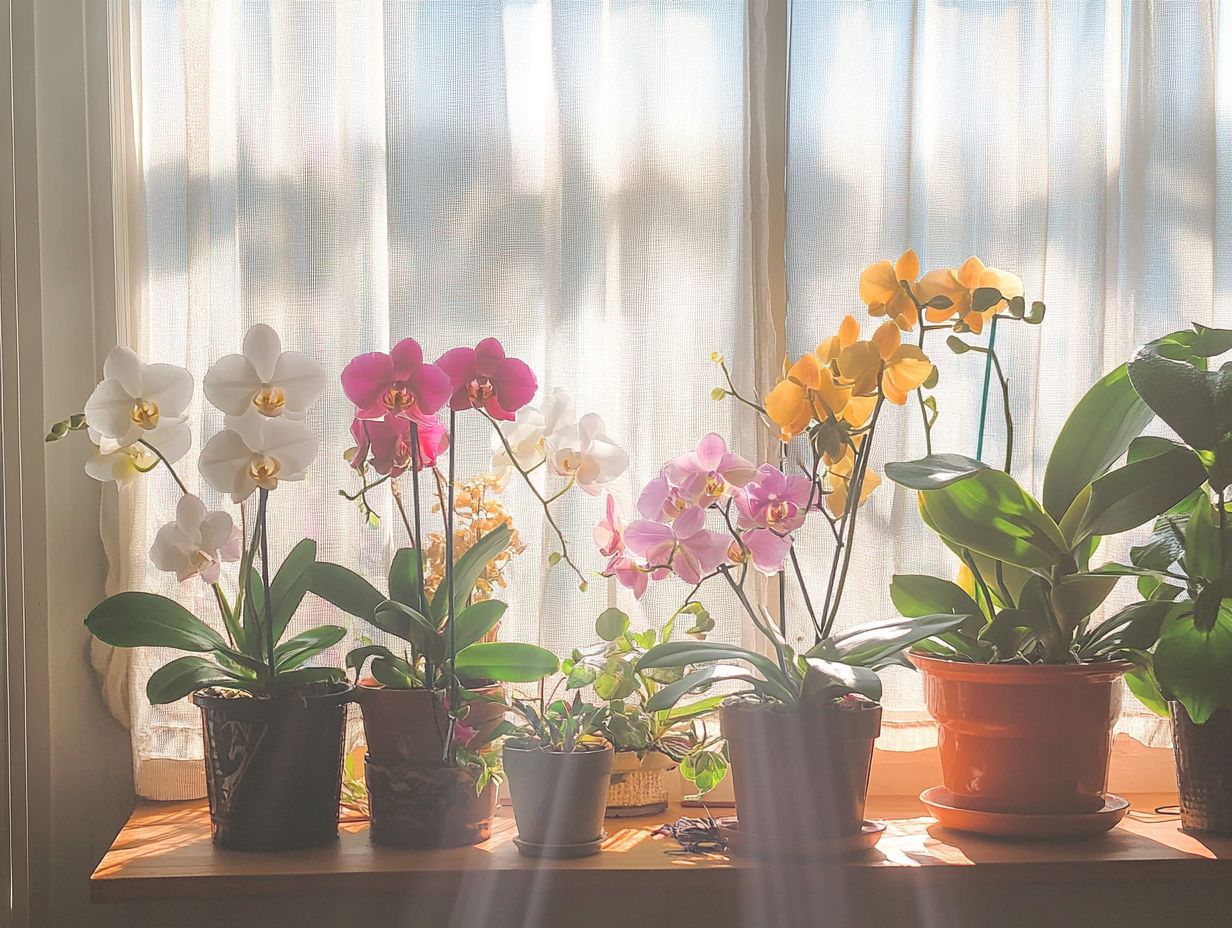
Caring for indoor orchids? Understanding the differences between natural and artificial light is key to your success! Natural light offers a rich spectrum of wavelengths that are vital for photosynthesis, the process plants use to convert light into energy.
Natural light provides a balanced environment, helping orchids thrive through seasonal changes. However, it can bring challenges, such as fluctuating intensity and unpredictable weather.
In contrast, artificial light delivers a steady and controlled environment. You can customize both the duration and intensity to meet the specific needs of different orchid varieties.
To maximize natural light, place your plants near east or west-facing windows. Rotate them regularly for even exposure.
If you prefer artificial light, consider using full-spectrum LED grow lights. These mimic sunlight effectively. Position them about 12-18 inches away from the plants to achieve optimal light levels. Most orchids thrive with 12-14 hours of light daily.
Setting Up a Lighting System for Orchids
Establishing an optimal lighting system is crucial for nurturing healthy, vibrant plants. This setup helps unlock their full growth potential.
Carefully consider the unique requirements of various orchid species. Address factors like light intensity, duration, and type to create the perfect environment for temperature and humidity.
Factors to Consider and Tips for Success
When setting up your lighting system for indoor orchids, consider light intensity, duration, and positioning. These factors are crucial for healthy plants and successful growth.
Some orchids thrive in bright, indirect sunlight, while others prefer lower light conditions. Knowing this can mean the difference between flourishing blooms and lackluster growth.
Adjusting the type of bulbs can greatly impact your results. For example, LED bulbs are well-known for their energy efficiency and longevity, making them ideal for sustained growth.
Fine-tune the height and angle of your light source to avoid direct glare, which can harm delicate leaves. Regularly rotating your plants ensures that all sections receive adequate light exposure, promoting even growth and vibrant flowers.
Common Light-Related Issues for Orchids
Light-related issues can severely impact the health and vitality of your orchids. As an orchid care enthusiast, staying vigilant is essential.
Problems like insufficient light, excessive light, and poor light quality can lead to weak growth, poor flowering, and even diseases that threaten your prized plants.
Identifying and Resolving Light Problems

Identifying and resolving light problems is crucial for maintaining the health of your indoor orchids. This ensures they flourish in their surroundings. Pay attention to signs of distress, such as leaf discoloration, slow growth, or a reluctance to bloom these often signal inadequate or excessive light conditions.
To systematically diagnose these light-related issues, start by assessing your plant’s placement within its environment. Observe how much natural light enters the space at different times of the day. This insight will guide you in determining whether adjustments are necessary.
If you find your orchids struggling in low light, consider relocating them closer to a window or supplementing their light sources with grow lights, artificial lights designed to support plant growth that emit the right spectrum. For optimal growth, it’s crucial to understand the light requirements for flowering indoor plants. On the flip side, if they’re basking in too much direct sunlight, try shading them with sheer curtains or moving them to an area with more filtered light. This can make a world of difference!
Regularly rotating your pots will ensure they receive even exposure, promoting balanced growth. Using reflective surfaces optimizes available light, enhancing the overall vitality of these stunning plants.
Best Practices for Managing Light Levels
Managing light levels is vital for vibrant orchids! Let s explore the best practices for nurturing healthy plants and fostering vibrant growth in your indoor orchids. By meticulously controlling light exposure and quality, you can create ideal conditions tailored to the unique needs of different orchid varieties.
Tips for Maintaining Optimal Light Conditions
Maintaining optimal light conditions for your indoor orchids requires consistent monitoring and thoughtful adjustments. This ensures that your plants receive the light they need for robust growth. You can employ various techniques to create an environment tailored to the specific light requirements of each orchid species.
Investing in a light meter will give you precise readings, allowing you to assess brightness levels in different areas of your home. Regularly rotating the pots will maximize exposure, preventing uneven growth that can hinder your orchids development. Sheer curtains can be a game-changer, diffusing harsh sunlight while still allowing sufficient brightness to filter through.
Implementing timers for your grow lights guarantees that your orchids receive a consistent photoperiod, which is crucial for their flowering cycles. By combining these tools and strategies, you can cultivate thriving orchids and achieve the perfect balance of light in your indoor garden. To ensure you meet their specific needs, consider understanding indoor plant light needs, even if you’re just starting out!
Frequently Asked Questions
What is light management for indoor orchids?
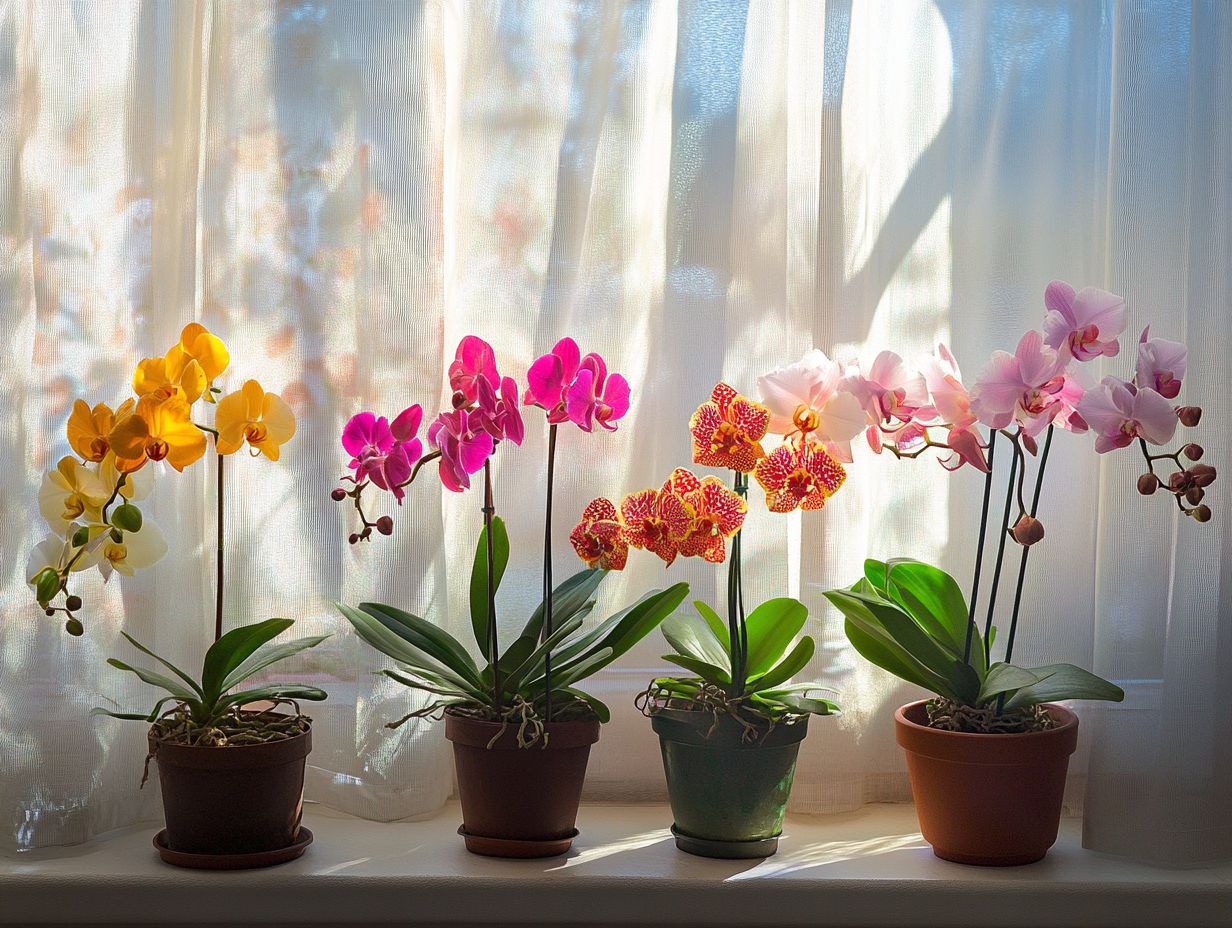
Light management for indoor orchids involves controlling the amount and quality of light that the plant receives. This promotes healthy growth and blooming. This includes factors such as the intensity, duration, and type of light, as well as understanding their light requirements.
Why is light management important for indoor orchids?
Light is essential for photosynthesis the process by which orchids convert light into energy. Proper light management ensures that healthy plants receive the right amount of light for optimal growth and blooming. Too little or too much light can be harmful to the plant.
What is the ideal light intensity for indoor orchids?
The ideal light intensity for indoor orchids varies depending on the types of orchids and their specific needs. Generally, orchids require bright, indirect light with an intensity of 1000-2000 foot-candles for optimal growth.
How do you determine the right amount of light for your indoor orchids?
One way to determine the right amount of light for your indoor orchids is to observe the leaves. If they are pale green, it may indicate that the plant is receiving too much light. If they are dark green, it may indicate that the plant is not receiving enough light. Adjust the light accordingly based on these observations, keeping in mind their humidity levels and ideal temperature.
Start monitoring your orchid s light today for a vibrant display tomorrow!
What are the different types of light for indoor orchids?
There are three main types of light for indoor orchids: natural light, artificial light, and fluorescent light.
Natural light is the best choice! If your orchids aren’t getting enough, you can add artificial lights like LED or fluorescent grow lights, which work wonders.
How do you create a good light management routine for your indoor orchids?
Start by understanding what your indoor orchids need in terms of light. Then, consistently provide the right amount and type of light.
As the seasons change, you may need to adjust your light setup. Keeping an eye on your light arrangement will help your orchids grow well and prevent issues like root rot.

